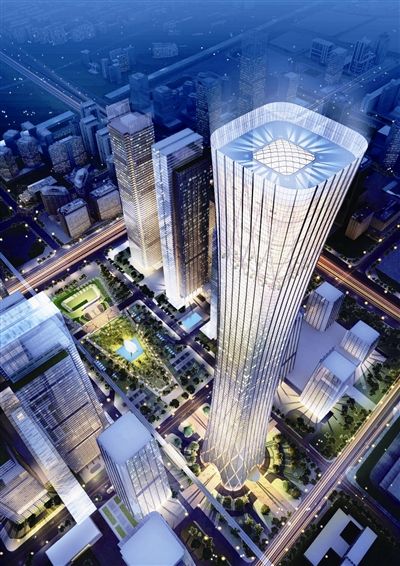Beijing seeks to raise its profile in the world
 0 Comment(s)
0 Comment(s) Print
Print E-mail
Shanghai Daily, September 6, 2011
E-mail
Shanghai Daily, September 6, 2011
|
An artist's impression of Zhongguo Zun in the CBD. The building, which will house offices of CITIC Group, will be the tallest in Beijing when it is finished, standing 510 meters. [Photo/China Daily] |
Beijing will begin building the city's tallest skyscraper next month in its central business district.
The 108-story 510-meter building, called China Zun, will surpass the 509m Taipei 101 Tower, currently the world's third-tallest building, and Shanghai's 492m World Financial Center, the current fourth.
The building - shaped like a zun, an ancient Chinese wine vessel, although the word can also mean "honorable" - will be the headquarters of state-owned Citic Group, according to the organizing committee of the Beijing Central Business District Commercial Festival to be held next week.
The committee said the building will have the texture of woven bamboo, while the top of the building will look like a flying lantern, both traditional Chinese symbols.
The building will dwarf most of the world's current skyscrapers, save the 828m Burj Khalifa in Dubai and the 601m Abraj Al-Bait Towers in Saudi Arabia, but will soon be outdone by other Chinese high-rises.
The Shanghai Tower, designed to reach an eventual height of 632m in Pudong's Lujiazui area, has already risen to the 20th floor and will be ready for use in January 2015. And Shanghai-based Greenland Group is to build a 606m building, ultimately the world's third-tallest, in Wuhan, Hubei Province, within five years.
Modern skyscrapers are mushrooming across China. More than 200 above 150m are under construction, according to a survey.
Fang Yuqing, a Shanghai expert on high-rises and a city government adviser, said: "The building spree will slow down because skyscrapers have huge energy needs and cost a lot in terms of daily management."
He said high-cost buildings can also raise safety concerns, such as the peril of falling objects.
"A city should be highlighted by its comprehensive power and cultures, rather than the height of its buildings," he said.
Shanghai is sinking at an average of a centimeter a year, according to research by Tongji University, and the city's profusion of high-rises have been blamed. Fang said city governments should limit the height of buildings.
Even some less populated Chinese cities and villages plan to build skyscrapers.
Fangchenggang City in the Guangxi Zhuang Autonomous Region has fewer than 1 million residents, yet it plans to build a 528m Asian International Financial Center, taller than the Shanghai World Financial Center.
Huaxi Village, in east China Jiangsu Province, once China's richest village, is to start building a 328m-high hotel next month which will be the eighth highest building in China and the 15th in the world when completed.







Go to Forum >>0 Comment(s)